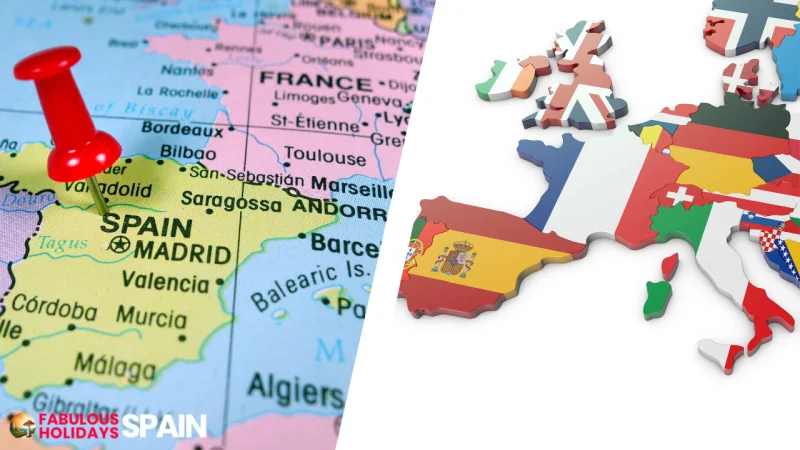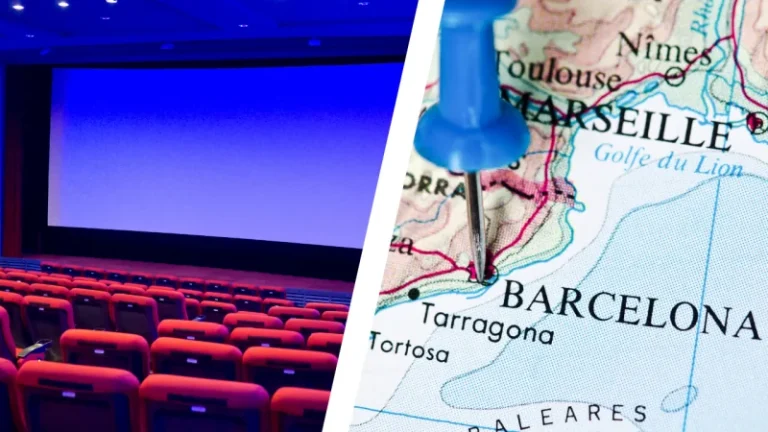What Should You Know Before Visit Spain?

I am providing you with an authentic, on-the-ground perspective. Read my full Authenticity Guarantee disclaimer.
In this guide, we will explore all the important facts about Spain you need to know before travelling to Spain.
Where is Spain located on the World Map?
Spain is located in southwestern Europe, occupying most of the Iberian Peninsula. It shares land borders with Portugal to the west, France to the northeast, and Andorra to the north.
The Mediterranean Sea lies to the east and south, while the Atlantic Ocean borders Spain to the northwest and west.
Spain also has two archipelagos, the Balearic Islands in the Mediterranean Sea and the Canary Islands in the Atlantic Ocean.
Spain’s location in southwestern Europe gives it a temperate Mediterranean climate, with warm, dry summers and mild, wet winters.
The country’s varied terrain, from the Pyrenees Mountains in the north to the Andalusian coast in the south, provides stunning landscapes and ecosystems.
What are Spain’s Coordinates?
Spain’s coordinates for latitude are 40.4637° N and longitude 3.7492° W.
What are the neighbouring countries of Spain?
Spain shares land borders with four countries:
- Portugal: Spain’s longest land border, spanning 1,288 kilometres (800 miles), runs along the western edge of the Iberian Peninsula.
- France: The border between Spain and France extends 858 kilometres (533 miles) along the Pyrenees Mountains, forming the northeastern boundary of Spain.
- Andorra: Spain shares a small border with Andorra, a microstate nestled within the Pyrenees, encompassing 60 kilometres (37 miles).
- Gibraltar: Spain maintains a disputed land border with the British Overseas Territory of Gibraltar, a small peninsula on the southern tip of the Iberian Peninsula. The border is 1.2 kilometres (0.7 miles) long.
In addition to these land borders, Spain has coastlines on the Mediterranean Sea, the Atlantic Ocean, and the Bay of Biscay. It also has two autonomous cities located in North Africa: Ceuta and Melilla.
Which Continent Is Spain Located In?
Spain is located primarily in Europe. It occupies about 85% of the Iberian Peninsula, which it shares with its smaller neighbour Portugal. However, it also has two archipelagos in the Atlantic Ocean: the Canary Islands and the Balearic Islands. Additionally, it has two enclaves in North Africa: Ceuta and Melilla.
Here is a breakdown of Spain’s territories and their corresponding continents:
- Iberian Peninsula (mainland Spain): Europe
- Canary Islands: Africa (technically, they are located in the Macaronesia region of Africa)
- Balearic Islands: Europe
- Ceuta: Africa
- Melilla: Africa
Therefore, Spain is considered a transcontinental country, with its territory spanning two continents: Europe and Africa.
What is the Area of Spain?
Spain has a total area of 506,030 square kilometres (195,365 square miles). This makes it the fifty-second-largest country in the world and the fourth-largest country in Europe. Most of Spain’s territory is located on the Iberian Peninsula, which it shares with Portugal and Andorra. However, Spain also includes the Canary Islands in the Atlantic Ocean, the Balearic Islands in the Mediterranean Sea, and the autonomous cities of Ceuta and Melilla in North Africa.
Here is a breakdown of Spain’s total area by landmass:
- Mainland Spain: 493,514 square kilometres (194,488 square miles)
- Canary Islands: 7,492 square kilometres (2,929 square miles)
- Balearic Islands: 4,992 square kilometres (1,924 square miles)
- Ceuta and Melilla: 32 square kilometres (12 square miles)
What is the population of Spain?
The current population of Spain is estimated to be 48,446,594 as of December 2023. This makes Spain the 32nd most populous country in the world and the fifth most populous in Europe. Spain’s population density is 95 people per square kilometre, which is slightly lower than the average for Europe.
What is the Spain Time Zone?
Spain uses Central European Time (CET) during the winter months (October to March) and Western European Summer Time (WEST) during the summer months (April to September). CET is 1 hour ahead of Greenwich Mean Time (GMT) and WEST is 2 hours ahead of GMT.
Specifically, the time zones in Spain are:
- Canary Islands: Western European Summer Time (WEST) from late March to late October, and Western European Time (WET) from late October to late March.
- Rest of Spain: Central European Summer Time (CEST) from late March to late October and Central European Time (CET) from late October to late March.
What is the Time Difference Between Spain and the United Kingdom?
The time difference between Spain and the United Kingdom depends on the time of year. In winter (October to March), Spain is 1 hour ahead of the United Kingdom. In summer (April to September), Spain is 2 hours ahead of the United Kingdom.
What is the Official Language of Spain?
The official language of Spain is Spanish, also known as Castilian Spanish. It is spoken by the vast majority of the population (over 92%) and is the language of education, government, and the media.
What is the Spoken Language in Spain?
In addition to the Spanish language, there are six other co-official languages in Spain:
- Catalan: Spoken in Catalonia, the Balearic Islands, and part of Valencia.
- Basque: Spoken in the Basque Country and part of Navarre.
- Galician: Spoken in Galicia.
- Aranese: Spoken in the Aran Valley in the Pyrenees.
- Valencian: It is spoken in the Valencian Community.
Although these languages are spoken by a minority of the population, they are recognised and protected by the Spanish Constitution.
Do Spaniards Speak English?
Yes, some Spaniards do speak English, but English proficiency in Spain is generally lower than in other European countries.
According to the EF English Proficiency Index, Spain ranks 26th out of 88 countries in English proficiency. This means that over 60% of Spaniards do not speak English at all, and of those who do, most have a limited or basic level of proficiency.
The level of English proficiency in Spain varies depending on location, age, and educational background.
Younger people and those who live in tourist areas are more likely to speak English. Additionally, those who have studied English in school are more likely to have a higher level of proficiency.
However, even among those who have studied English, many people cannot hold conversations in the language.
Which Language Is Spoken In Official Offices In Spain?
The language spoken in official offices in Spain depends on the region. In Spain, Spanish (Castilian) is the official language used in most official settings. However, other co-official languages are also used in official offices in some regions. These languages include:
- Catalan: Spoken in Catalonia, the Balearic Islands, and part of Valencia
- Basque: Spoken in the Basque Country and part of Navarre
- Galician: Spoken in Galicia
- Aranese: Spoken in the Aran Valley in the Pyrenees
- Valencian: A dialect of Catalan spoken in the Valencian Community
In these regions, official documents and signage are typically available in Spanish and the co-official languages. However, the language used in everyday interactions in official offices may vary depending on the specific location and the language preferences of the staff and the public.
What is the Spanish Alphabet?
The Spanish alphabet, or “abecedario” or “alfabeto,” consists of 27 letters: 22 consonants and 5 vowels. The consonants are:
a, b, c, ch, d, e, f, g, h, i, j, k, l, ll, m, n, ñ, o, p, q, r, s, t, u, v, w (uve doble), x, y, z
The vowels are:
a, e, i, o, u
The letters “ñ” and “ll” are considered separate letters, not digraphs, as they have unique pronunciations. The letter “h” is silent unless it is followed by “c” or “u” to form the sound “ch”. The letter “q” is always followed by “u” to form the syllable “qu”.
What is Spain International Telephone Area and Country Code?
The international telephone area code for Spain is +34. This code is used to dial Spain from any other country. When calling from Spain to another country, the international access code is 00.
What is a Spanish Vehicles Plate?
A Spanish plate, also known as a Spanish license plate, is a unique identifier for motor vehicles registered in Spain. It consists of four numbers followed by three letters, all of which are black on a white background.
The letters used are B, C, D, F, G, H, J, K, L, M, N, P, R, S, T, V, W, X, Y, and Z. The letter Q is not used, and all vowels are also excluded. The current system allows for 80 million possible combinations.

The first four numbers are a sequential counter, which starts at 0000 and increments up to 9999. Once a counter reaches 9999, the next set of three letters is used. The sequence of letters starts with BBB and ends with ZZZ. At the current rate of vehicle registrations, the system is expected to last until around 2040.
The format of Spanish plates has changed over time. Before the current system, Spain used a regional letter code system, with different letters assigned to different regions. The current system was introduced in 2000 and is expected to remain in use for many years.
Here are some additional details about Spanish plates.
Red plates: Red plates are used for trailers and caravans.
Diplomatic plates: Diplomatic plates are either red, green, yellow, or blue and start with the letters “CD” (red) for diplomatic cars, “CC” (green) for consular cars, “TA” (yellow) for ancillary workers’ cars or “OI” (blue) for cars belonging to international organisations. The first set of numbers stands for the embassy or organisation and the second for the specific car from an organisation.
Foreign registered vehicles: Foreign registered vehicles in Spain must display the registration plates of their country of origin unless they are exempt from doing so.
What is Spain’s Internet Domain?
The country code top-level domain (ccTLD) for Spain is .es. It is administered by the Network Information Centre of Spain (Red.es).
.es domains are registered at the second or third level beneath various generic second-level categories. Depending on which second-level domain they are within, some qualifications and restrictions apply to third-level registrations.
Second-level registrations have had some limitations, including requiring registrants to have a connection with Spain, but these restrictions were lifted in a multi-stage process completed by the end of 2005, at which point registrations at the second level of .es were open to anybody worldwide.
.es domains are very popular in Spain, with over 4.9 million domains registered as of October 2023. Businesses and organizations in other Spanish-speaking countries, such as Mexico, Argentina, and Chile, also use them.
Here are some of the benefits of using a .es domain:
- Brand recognition: A .es domain can help you build brand recognition in Spain, as it is associated with the country.
- Local SEO: A .es domain can help your website rank higher in search engine results pages (SERPs) for local searches in Spain.
- Targeted marketing: A .es domain allows you to target your marketing efforts to Spanish speakers.
What is the Abbreviation for Spain?
The abbreviation for Spain is ES. This abbreviation is used in international organizations, such as the United Nations and the European Union, and in various contexts, such as sports competitions and currency exchange.
Here are some examples of how the abbreviation ES is used for Spain:
- International Organization for Standardization (ISO) country code: ES
- International Olympic Committee (IOC) country code: ESP
- FIFA country code: ESP
- European Union member state code: ES
Which are the provinces of Spain?
Spain is divided into 17 autonomous communities and two autonomous cities:
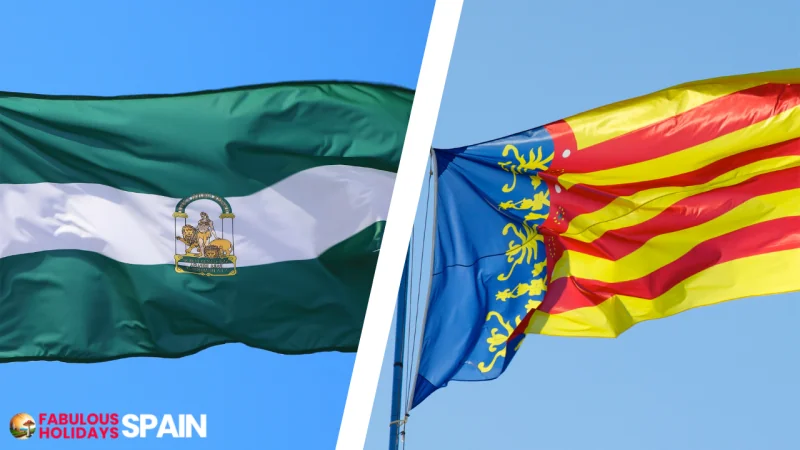
Autonomous Communities
- Andalusia (Andalucía)
- Aragon (Aragón)
- Asturias (Asturias)
- Balearic Islands (Illes Balears)
- Basque Country (Euskadi)
- Canary Islands (Islas Canarias)
- Cantabria (Cantabria)
- Castile and León (Castilla y León)
- Castile–La Mancha (Castilla-La Mancha)
- Catalonia (Cataluña)
- Community of Madrid (Comunidad de Madrid)
- Extremadura (Extremadura)
- Galicia (Galicia)
- La Rioja (La Rioja)
- Navarre (Navarra)
- Region of Murcia (Región de Murcia)
- Valencian Community (Comunidad Valenciana)
Autonomous Cities
- Ceuta
- Melilla
What are the cities of Spain?
| City | Population |
| Madrid | 6,741,803 |
| Barcelona | 1,515,900 |
| Valencia | 898,873 |
| Seville | 726,377 |
| Zaragoza | 671,853 |
| Málaga | 583,404 |
| Bilbao | 387,573 |
| Granada | 243,192 |
| Murcia | 480,877 |
| Córdoba | 336,527 |
| Alicante | 437,573 |
| Valladolid | 310,905 |
| Vigo | 297,572 |
| Gijón | 292,274 |
| Terrassa | 235,573 |
| Badalona | 225,904 |
| Oviedo | 227,274 |
| La Coruña | 240,905 |
| Castellón de la Plana | 207,572 |
| Pamplona | 207,573 |
| Santa Cruz de Tenerife | 520,231 |
| Las Palmas de Gran Canaria | 408,572 |
| Albacete | 176,573 |
| Santander | 220,904 |
| Logroño | 68,572 |
What is the Capital of Spain?
The capital of Spain is Madrid.
Where is Madrid in Spain?
Madrid is located in the centre of the Iberian Peninsula, on the southern Meseta Central, 60 km south of the Guadarrama mountain range. It straddles the Jarama and Manzanares River sub-drainage basins in the wider Tagus River catchment area.
Madrid is the second-highest capital of Europe (after Andorra la Vella), with an average altitude of 650 m (2,130 ft).
What are the places to visit in Spain?
Spain is a country with a rich history and culture, and there are many places to visit that offer something for everyone. Here are a few of the most popular tourist destinations in Spain:
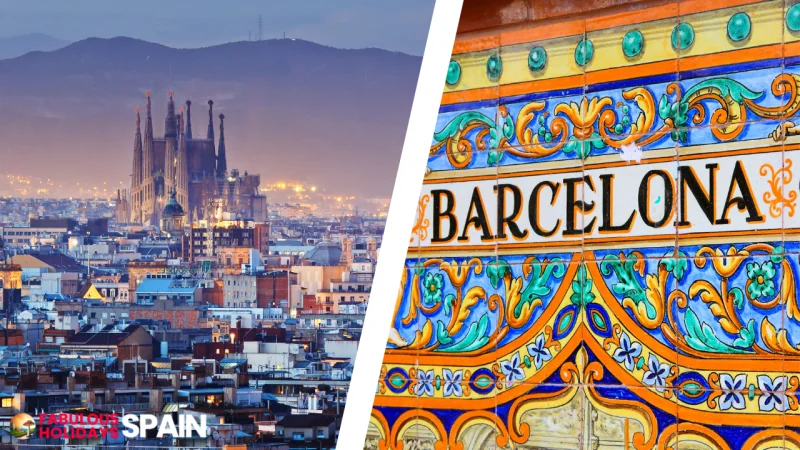
- Barcelona: Barcelona is the capital of Catalonia and one of Spain’s most popular tourist destinations. It is known for its beautiful architecture, including the Sagrada Família and Park Güell, as well as its lively atmosphere and its many beaches.
- Madrid: Madrid is the capital of Spain and has a lot to offer visitors. It is home to the Prado Museum, one of the world’s largest art museums, and the Royal Palace and the Royal Botanical Gardens. Madrid is also a great place to experience Spanish culture, with its many tapas, bars, flamenco shows, and bullfights.
- Seville: Seville is the capital of Andalusia, a beautiful city with a rich history. It is known for its flamenco, tapas, and Moorish architecture, including the Alcázar and the Seville Cathedral.
- Granada: Granada is a city in Andalusia home to the Alhambra, a Moorish palace complex, one of Spain’s most popular tourist attractions. Granada is known for its tapas, flamenco, and Moorish architecture, including the Albaicín district.
- Tarifa: Tarifa is a town in Andalusia that is located on the Strait of Gibraltar. It is a popular spot for windsurfing and kitesurfing, and it is also a great place to experience Moroccan culture, as it is only 14 kilometres from Morocco.
- Mallorca: Mallorca is one of the Balearic Islands and a popular tourist destination for its beaches, nightlife, and mountains. It is also home to the ancient city of Pollença and the Sóller Tramway, a historic tram that takes visitors through the Tramuntana Mountains.
- Tenerife: Tenerife is one of the Canary Islands and is the largest island in the archipelago. It is a popular tourist destination for its beaches, its volcanoes, and its nightlife. It is also home to Mount Teide, the highest mountain in Spain.
- Ibiza: Ibiza is one of the Balearic Islands and a popular tourist destination for its beaches, nightlife, and party atmosphere. It is also home to the Dalt Vila, a UNESCO World Heritage Site located in the Old Town of Ibiza.
What is the Spanish Economy like?
Spain is a developed economy with the 14th largest GDP in the world. The economy is based on services, which account for about 70% of GDP. The main sectors include tourism, retail, finance, and telecommunications. Industry accounts for about 26% of GDP, and agriculture accounts for about 4%.
Spain’s economy is highly open to trade, with exports accounting for about 36% of GDP. The European Union, China, and the United States are the main trading partners.
Spain has a strong social safety net, with a comprehensive healthcare system and generous unemployment benefits. The country also has a high level of education, with a literacy rate of over 98%.
However, Spain has also faced some challenges in recent years, including the 2008 financial crisis and the COVID-19 pandemic. The country has a high debt-to-GDP ratio, and unemployment is still above pre-crisis levels.
Despite these challenges, Spain is a resilient economy with a strong track record of growth. The country is expected to continue to grow in the coming years, driven by strong consumer spending and investment.
What is the Currency of Spain?
The official currency of Spain is the euro (€). The euro is the European Union’s single currency and is used by 19 out of 27 EU member states.
It was introduced in 1999 as an accounting currency and replaced eleven national currencies, including the Spanish peseta, on 1 January 2002.
The euro is subdivided into 100 cents. Euro banknotes and coins are minted by the Eurosystem, which consists of the European Central Bank (ECB) and the national central banks of the member states whose currency is the euro.
How much is Spain’s currency?
As of today, December 30, 2023, the euro is worth the following against the top 20 world currencies:
- USD: 1.1050
- JPY: 156.33
- GBP: 0.86905
- HUF: 382.80
- CZK: 24.724
- DKK: 7.4529
- NOK: 11.0965
- PLN: 4.3395
- RON: 4.9756
- CHF: 0.9260
- ISK: 150.00
- CAD: 1.3627
- AUD: 1.5655
- NZD: 1.7504
- BRL: 5.3618
- CNY: 7.8509
- HKD: 8.6314
- IDR: 14,705.00
- INR: 84.535
- KRW: 1,340.67
- MXN: 22.3006
- MYR: 4.3919
- PHP: 52.564
- SGD: 1.4576
- THB: 36.858
- TWD: 28.336
- VND: 24,519.00
- ZAR: 16.017
Please note that the exchange rates are constantly changing, so the values above may not be accurate for long. Checking the latest exchange rates before making any transactions is always best.
To calculate the current exchange rate please visit the official European Commission website.
What is the National Income per Capita in Spain?
In 2022, Spain’s national income per capita was €38,386. This means that the average Spaniard earned €38,386 per year.
Spain’s national income per capita has been steadily increasing in recent years, from €28,611 in 2012 to €38,386 in 2022. This growth is due to several factors, including economic growth, rising employment rates, and increased investment in education and training.
However, there is still significant variation in income levels across Spain. For example, the national income per capita in the Basque Country is €44,545, while the national income per capita in Extremadura is €24,379.
The government is taking steps to address this inequality, such as investing in education and training in poorer regions. However, it is a complex issue that will take time to resolve.
Here is a table showing the national income per capita in Spain for the past 10 years:
| Year | National Income per Capita (€) |
| 2022 | 38,386 |
| 2021 | 35,926 |
| 2020 | 33,656 |
| 2019 | 31,498 |
| 2018 | 29,450 |
| 2017 | 27,513 |
| 2016 | 25,688 |
| 2015 | 23,976 |
| 2014 | 22,376 |
| 2013 | 20,890 |
What is Spain’s GDP?
Spain’s GDP in 2022 was €1.475 trillion, which means that the total value of all goods and services produced in Spain in 2022 was €1.475 trillion.
Spain’s GDP has been steadily increasing in recent years, from €1.184 trillion in 2020 to €1.475 trillion in 2022. This growth is due to many factors, including economic recovery from the COVID-19 pandemic, strong consumer spending, and increased investment in business and infrastructure.
Spain’s GDP per capita is also increasing, from €33,656 in 2020 to €38,386 in 2022. This is due to the same factors that are driving Spain’s overall GDP growth.
Spain’s economy is expected to continue growing in the years to come. With a strong track record of growth, the country is well-positioned to benefit from the global economic recovery.
Here is a table showing Spain’s GDP for the past 10 years:
| Year | GDP (€) |
| 2022 | 1,475 trillion |
| 2021 | 1,328 trillion |
| 2020 | 1,184 trillion |
| 2019 | 1,232 trillion |
| 2018 | 1,164 trillion |
| 2017 | 1,136 trillion |
| 2016 | 1,118 trillion |
| 2015 | 1,109 trillion |
| 2014 | 1,091 trillion |
| 2013 | 1,063 trillion |
Where does Spain rank in the Human Development Index?
Spain’s Human Development Index (HDI) in 2023 was 0.876, which ranks it 24th out of 195 countries in the world. This means that Spain has a high standard of living, with good access to education, healthcare, and a long life expectancy.
The HDI is a composite index that measures three dimensions of human development:
- Life expectancy at birth: This measures the average number of years that a person can expect to live in a given country.
- Education measures the average number of years of schooling a person has completed and the expected number of schooling years for children.
- Standard of living: This measures a country’s average income per capita.
Spain’s HDI has been increasing steadily in recent years, from 0.797 in 2013 to 0.876 in 2023. This is due to many factors, including economic growth, investments in education and healthcare, and social policies that promote equality.
However, some challenges remain to address in Spain, such as high levels of poverty and inequality. The government is working to address these issues, but it will take time to make a significant difference.
What is the Welfare Level in Spain?
Spain’s welfare level is generally considered to be high. The country has a strong social safety net, with a comprehensive healthcare system and generous unemployment benefits. The country also has a high level of education, with a literacy rate of over 98%.
However, some challenges need to be addressed in Spain. The country has a high debt-to-GDP ratio, and unemployment is still above pre-crisis levels. The government is taking steps to address these issues, but it will take time to make a significant difference.
Here is a table showing some of the key indicators of welfare in Spain:
| Indicator | Value |
| Life expectancy at birth | 83.2 years |
| Literacy rate | 98.7% |
| Unemployment rate | 12.4% |
| Poverty rate | 16.7% |
Where is Spain in the Happiness Ranking?
According to the latest World Happiness Report, Spain is ranked 32nd among 146 countries worldwide. The report, compiled by the UN Sustainable Development Solutions Network, assesses national happiness based on factors such as GDP per capita, life expectancy, social support, freedom, trust, and generosity.
Spain has consistently ranked among the top 30 happiest countries in the world, indicating a high level of well-being and social cohesion. The country’s strong social safety net, excellent healthcare system, and vibrant culture contribute to its high happiness ranking.
What is the Military Strength of Spain?
Spain is a member of the North Atlantic Treaty Organization (NATO) and has a strong military, which Global Firepower ranks 14th in the world.
The country has a professional force of over 120,000 active personnel and a reserve of over 41,000 troops.
The Spanish military is well-equipped with modern weapons and technology, including F-18 fighter jets, Leopard 2A6 main battle tanks, and Pizarro infantry fighting vehicles.
The Spanish military has a long and proud history, dating back to the 16th century. The country has a strong tradition of military service, and many Spaniards are proud of their armed forces.
Here are some of the key strengths of the Spanish military:
- Strong NATO membership: Spain is a member of NATO, which gives it access to advanced military technology and training.
- Modern equipment: The Spanish military is well-equipped with modern weapons and technology, which makes it a formidable force.
- Professional personnel: The Spanish military has a professional force of over 120,000 active personnel who are well-trained and motivated.
- Reserve force: Spain also has a reserve of over 41,000 troops, which can be called up in times of crisis.
- Strategic location: Spain is located in a strategic location in the Mediterranean Sea, which gives it access to important shipping lanes and oil fields.
However, Spain also faces some challenges in terms of its military strength:
- Declining defence spending: Spain’s defence spending has been declining in recent years, which could limit the country’s ability to invest in new equipment and training.
- Ageing equipment: Some of Spain’s equipment is ageing, which could increase the risk of breakdowns and malfunctions.
- Recruitment challenges: Spain is facing challenges in recruiting and retaining young people for military service.
Despite these challenges, Spain’s military remains a strong force that is capable of defending the country’s interests. The country is committed to modernizing its military and strengthening its ties with NATO.
What is Spain’s National Policy?
Spain’s policies are based on several principles, including:
- Social justice: Spain is committed to providing social justice for all of its citizens. This includes a strong social safety net, universal healthcare, and equal opportunities for all.
- Sustainability: Spain is committed to sustainable development, which means balancing economic growth with environmental protection. This includes investing in renewable energy, reducing pollution, and protecting biodiversity.
- European integration: Spain is a strong supporter of European integration. The country believes that working together with other European countries is the best way to address common challenges and promote peace and prosperity.
- International cooperation: Spain is committed to international cooperation. It is active in several international organizations and provides development aid to needy countries.
In addition to these general principles, Spain has several specific policies. Some of these policies include:
- The welfare state: Spain has a comprehensive welfare state that provides social protection for all citizens. This includes unemployment benefits, pensions, and healthcare.
- The educational system: Spain has a strong, free, compulsory educational system for all children up to the age of 16. The country is also investing in higher education to improve skills and competitiveness.
- The environmental policy: Spain is committed to reducing its environmental impact. The country has set ambitious targets for renewable energy and is investing in cleaner technologies.
- Foreign policy: Spain is a member of the European Union and NATO and is actively involved in international organizations such as the United Nations and the Organization of American States.
What is the Spanish Government Style?
Spain is a parliamentary monarchy, which means that the head of state is a king or queen who has a ceremonial role, while the head of government is a prime minister who is elected by the parliament.
The Spanish parliament is bicameral, which means that it has two chambers: the Congress of Deputies and the Senate. The Congress of Deputies is the lower house, and it is directly elected by the people. The Senate is the upper house, and it is indirectly elected by the regional parliaments.
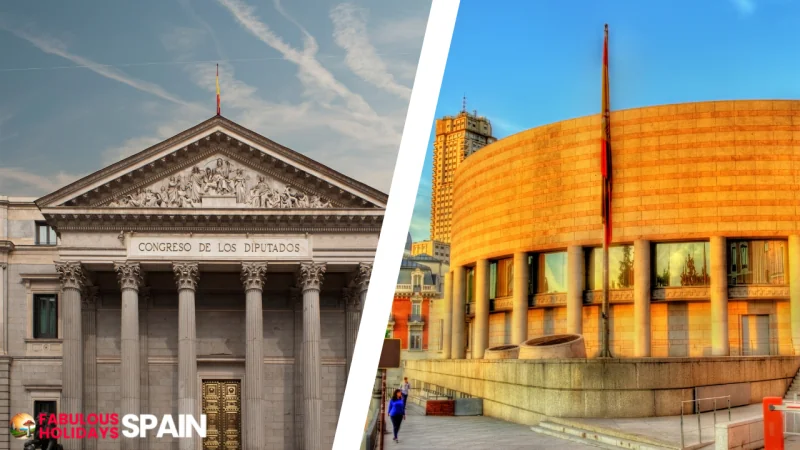
The Spanish government is responsible for the country’s day-to-day operations. It is made up of the Cabinet, which is headed by the prime minister. The Cabinet is responsible for proposing legislation, implementing laws, and conducting foreign policy.
The Spanish government is based on the principle of separation of powers, which means that the legislative, executive, and judicial branches of government are separate and independent of each other. This is designed to prevent any one branch from becoming too powerful.
The Spanish government is a complex system of checks and balances that is constantly evolving as the country faces new challenges and opportunities.
The core principles of parliamentary monarchy, bicameralism, and separation of powers will likely remain at the heart of the Spanish government for many years.
Here are some of the key features of the Spanish government:
- Parliamentary monarchy: The head of state is the king or queen with a ceremonial role. The head of government is the prime minister, who is elected by the parliament.
- Bicameral parliament: The parliament has two chambers: the Congress of Deputies and the Senate. The Congress of Deputies is the lower house, and it is directly elected by the people. The Senate is the upper house, and it is indirectly elected by the regional parliaments.
- Separation of powers: The legislative, executive, and judicial branches of government are separate and independent of each other.
What are the International Agreements Involving Spain?
Spain is a member of numerous international organizations and has signed many treaties and agreements. Here are some of the most important international agreements involving Spain:
North Atlantic Treaty Organization (NATO)
Spain joined NATO in 1982 and is an active member of the alliance. The country contributes to NATO’s military operations and missions, and it also hosts NATO facilities on its territory.
European Union (EU)
Spain has been a member of the EU since 1986. The country actively participates in the EU’s decision-making processes, and it benefits from the EU’s single market, common currency, and other economic policies.
United Nations (UN)
Spain is a founding member of the UN and actively participates in the organization’s work. The country contributes to peacekeeping missions, humanitarian assistance, and other UN initiatives.
Organizacion de Estados Americanos (OEA)
Spain is a member of the OEA, the regional organization for the Americas. The country participates in the OEA’s work on democracy, human rights, and other issues.
Organización para la Cooperación y el Desarrollo Económicos (OCDE)
Spain joined the OECD in 1961. The organization is a forum for cooperation among governments on economic and social issues. Spain participates in the OECD’s work on taxation, trade, education, and other issues.
Organización Mundial del Comercio (OMC)
Spain joined the OMC in 1986. The organization is responsible for regulating international trade. Spain participates in the OMC’s work on trade negotiations, dispute settlement, and other issues.
In addition to these major international organizations, Spain has signed many bilateral agreements with other countries. These agreements cover a variety of issues, including trade, investment, tourism, and cultural cooperation.
Spain’s participation in international organizations and its network of bilateral agreements are important for the country’s economic, political, and security interests. The country benefits from access to international markets, cooperation on shared challenges, and support for its foreign policy goals
Is Spain a Schengen Country?
Yes, Spain is a Schengen country. This means that there are no internal border controls between Spain and other Schengen countries. This allows people to travel freely between these countries without showing their passports or going through customs checkpoints.
The Schengen Agreement is an agreement between 26 European countries that allows for the free movement of people within these countries. The agreement was signed in 1985 and came into force in 1995.
There are a few exceptions to the Schengen Agreement. For example, there are still internal border controls between France and Spain in the Pyrenees mountains and between Norway and Sweden.
However, most of the Schengen area is free of internal border controls. This makes it easy for people to travel between these countries and has helped boost tourism and trade in the region.
What are the symbols of Spain?

Spain has a rich and diverse history, and its symbols reflect this heritage. Here are some of the most important symbols of Spain:
- The Spanish coat of arms: The Spanish coat of arms is a complex emblem that includes a shield with a pomegranate, a yoke, arrows, and a crown. The pomegranate represents Granada, the last Moorish kingdom to fall to the Christians in 1492. The yoke and arrows represent the Catholic Monarchs Ferdinand and Isabella, who unified Spain in 1479. The crown represents the Spanish monarchy.
- The Spanish bull: The Spanish bull is a symbol of Spain’s national sport, bullfighting. Bulls are also associated with courage and masculinity in Spanish culture.
- The flamenco: Flamenco is a traditional Spanish dance that is characterized by its fiery passion and rhythmic clapping. It is a symbol of Spain’s vibrant culture and history.
- The Sagrada Familia: The Sagrada Familia is a large unfinished basilica in Barcelona, Spain. It is a symbol of Catalan pride and creativity.
- The Alhambra: The Alhambra is a Moorish palace and fortress in Granada, Spain. It symbolizes Spain’s rich history and cultural heritage.
- The Picasso Museum: The Picasso Museum in Barcelona is home to the world’s largest collection of Picasso’s work. It is a symbol of Barcelona’s status as a centre of art and culture.
What is the Spanish Flag like?
The national flag of Spain is called the Rojigualda, which means “red and yellow” in Spanish. It is a horizontal tricolour consisting of two equal vertical stripes of red (hoist side) and yellow (fly side) separated by a narrow white stripe.
The flag was adopted in 1931, and the colors have symbolic meanings. The red stripes represent the blood of Spaniards who have fought for their country, while the yellow stripe represents the wealth of Spain’s soil. The white stripe symbolizes peace and unity.
What are the transportation conditions in Spain?
Spain has a well-developed transportation infrastructure, with various options for getting around the country. Here’s a breakdown of the different modes of transportation in Spain:
Roads:
- Spain has a comprehensive network of highways and roads, with over 164,000 kilometres of paved roads.
- The extensive motorway system covers all major cities and connects the country with France, Portugal, and other European countries.
- Toll roads are common in Spain, and various toll payment options are available.
- Driving in Spain is generally safe and efficient, but it is important to be aware of the local traffic rules and regulations.
Rail:
- Spain has a well-developed rail network, with over 17,000 kilometres of track.
- The high-speed AVE train network connects major cities such as Madrid, Barcelona, Seville, and Valencia.
- Regional trains and Cercanías commuter trains also provide convenient service within cities and between smaller towns.
- Rail travel in Spain is a comfortable and environmentally friendly option, but it can be more expensive than bus travel.
Public transport:
- Spain has an extensive public bus network connecting all major cities and towns.
- Buses are a convenient and affordable way to travel around the country, especially for shorter distances.
- There are also a variety of tourist buses that offer hop-on and hop-off services in popular destinations.
- Public transport in Spain is generally safe and efficient, but it can be crowded during peak hours.
Air travel:
- Spain has two major international airports, Madrid-Barajas Adolfo Suárez and Barcelona-El Prat Josep Tarradellas.
- There are also several regional airports serving smaller cities and towns.
- Air travel is a fast and convenient way to travel between different parts of Spain, but it can be more expensive than other modes of transportation.
Taxis:
- Taxis are readily available in Spain and a convenient way to get around cities and towns.
- Taxi fares are generally metered, but there may be surcharges for night fares and extra passengers.
- Taxis are a safe and reliable option for getting around but can be more expensive than public transport.
Overall, Spain has a well-developed transportation infrastructure that makes it easy to get around the country. There are a variety of options for every budget and traveller, from high-speed trains and buses to taxis and private cars.
What is the Spanish Education System like?
The Spanish education system is divided into three main stages:
Pre-School Education (Educación Infantil)
This stage is compulsory for children aged 3 to 6 years old. It is divided into two cycles: the Early Childhood Education Cycle (Educación Infantil de Primer Ciclo) and the Middle Childhood Education Cycle (Educación Infantil de Segundo Ciclo). The Early Childhood Education Cycle focuses on developing children’s physical, social, and emotional skills, while the Middle Childhood Education Cycle focuses on developing children’s language, literacy, numeracy, and cognitive skills.
Compulsory Education (Educación Primaria)
This stage is compulsory for children aged 6 to 12 years old. It is divided into six years: the First Year of Primary Education (Primer Ciclo de Educación Primaria), the Second Year of Primary Education (Segundo Ciclo de Educación Primaria), the Third Year of Primary Education (Tercer Ciclo de Educación Primaria), the Fourth Year of Primary Education (Cuarto Ciclo de Educación Primaria), the Fifth Year of Primary Education (Quinto Ciclo de Educación Primaria), and the Sixth Year of Primary Education (Sexto Ciclo de Educación Primaria). Each year focuses on developing specific skills and knowledge.
Secondary Education (Educación Secundaria Obligatoria)
This stage is compulsory for children aged 12 to 16 years old. It is divided into three years: the First Year of Secondary Education (Primer Año de Educación Secundaria Obligatoria), the Second Year of Secondary Education (Segundo Año de Educación Secundaria Obligatoria), and the Third Year of Secondary Education (Tercer Año de Educación Secundaria Obligatoria). Each year focuses on developing specific skills and knowledge.
Baccalaureate (Bachillerato)
This stage is optional for students aged 16 to 18 years old. It is divided into two years: the First Year of Baccalaureate (Primer Curso de Bachillerato) and the Second Year of Baccalaureate (Segundo Curso de Bachillerato). Each year focuses on developing specific skills and knowledge for specific fields of study.
Higher Education (Educación Superior)
This stage is optional for students who have completed the Baccalaureate. It is divided into three main areas:
- Universities: Universities offer a variety of undergraduate and postgraduate degrees, as well as research opportunities.
- Vocational Education and Training (FP): FP programs offer practical training in specific fields, such as technology, healthcare, and business.
- Adult Education: Adult education programs offer opportunities for people who want to improve their skills or learn new subjects.
The Spanish education system is constantly evolving, and there are several reforms currently being implemented. These reforms aim to make the education system more equitable, inclusive, and efficient.
Here are some of the key features of the Spanish education system:
- Compulsory education for all children aged 6 to 16 years old.
- Free education at all levels of schooling.
- A decentralized education system, with responsibility for education, devolved to the regional governments.
- A focus on developing critical thinking, problem-solving, and communication skills.
- A growing emphasis on vocational education and training.
The Spanish education system is a valuable asset for the country. It provides young people with the skills and knowledge they need to succeed in life. The system is also committed to promoting social mobility and ensuring that all children have equal opportunities.
What is the Social Structure of Spain?
Spain’s social and political structure is characterized by a high degree of social mobility and a strong sense of egalitarianism. The country has a long history of social reform, and this has led to a society that is relatively open and accepting of diversity.
Social Mobility
Spain is one of the most socially mobile countries in the world. This means that people can move up the social ladder based on their own merits and abilities. This is due in part to the country’s strong education system, which provides opportunities for all citizens to develop their skills and knowledge.
Egalitarianism
Spain has a strong tradition of egalitarianism, which means that people are treated equally, regardless of their social background or wealth. This is reflected in the country’s welfare system, which provides support for those in need. It is also reflected in the country’s culture, which is generally welcoming and inclusive.
Diversity
Spain is a diverse country with a rich history of immigration. This diversity is reflected in the country’s population, which is made up of people from all over the world. This diversity is celebrated in Spain, and it is seen as a source of strength.
Challenges
Despite its many strengths, Spain’s social structure also faces some challenges. One challenge is the high level of unemployment, which has been a problem for the country for many years. Another challenge is the high level of inequality, which has been increasing in recent years.
What are the Cultural Characteristics of Spain?
Spain has a rich and diverse culture that has been shaped by its history, geography, and people. Here are some of the key cultural characteristics of Spain:
Family: Family is very important in Spanish culture. Spaniards often live with their extended families, and they value strong family bonds. Family gatherings are often large and festive, and they are a time for sharing food, laughter, and conversation.
Friendship: Spaniards also place a high value on friendship. They enjoy spending time with their friends, and they are known for their warmth and hospitality. Friendships are often formed in childhood and last a lifetime.
Food: Food is a central part of Spanish culture. Spaniards love to cook and eat, and they take great pride in their cuisine. Spanish food is varied and flavorful, and it reflects the country’s diverse influences.
Art: Spain has a rich artistic tradition, which includes painting, sculpture, architecture, and literature. Spanish artists have made significant contributions to world culture, and their work is celebrated around the world.
Music: Music is also an important part of Spanish culture. Spaniards love to dance, and they have a wide variety of traditional dances, including flamenco and sardana. Spanish music is also known for its passion and energy, and it has influenced music genres around the world.
Literature: Spanish literature is also highly regarded. Spanish writers have produced some of the world’s most famous works of literature, including Don Quixote by Miguel de Cervantes and La Celestina by Fernando de Rojas.
Religion: Spain is a largely Catholic country, and religion plays an important role in the lives of many Spaniards. However, Spain is also a tolerant society, and people of all religions are free to practice their faith.
Festivals: Spain is a country of festivals. There are festivals throughout the year, celebrating everything from religious events to local traditions. These festivals are a great way to experience Spanish culture and enjoy the company of the locals.
Sports: Sports are also popular in Spain. Football (soccer) is the most popular sport, and Spain has a national team that has won the World Cup and the European Championship. Other popular sports include basketball, tennis, and bullfighting.
What is the Architectural Structure of Spain?
Spain’s architectural structure is a blend of different styles from throughout history, reflecting its rich cultural heritage and the influence of various civilizations. Here are the most notable styles in Spanish architecture:
Roman architecture: Spain was part of the Roman Empire for over 700 years, and Roman architecture left a lasting legacy on the country’s built environment. Roman aqueducts, arches, and temples can be found all over Spain, and they are a testament to the empire’s engineering prowess.
Moorish architecture: In the 8th century, Moorish conquerors from North Africa invaded Spain, and they brought with them their unique architectural style. Moorish architecture is characterized by its use of arches, domes, and intricate tilework. Notable examples of Moorish architecture in Spain include the Alhambra Palace in Granada and the Mezquita Cathedral in Córdoba.
Romanesque architecture: In the 11th and 12th centuries, Romanesque architecture became the dominant style in Spain. Romanesque churches are characterized by their round arches, thick walls, and barrel vaults. Notable examples of Romanesque architecture in Spain include the Cathedral of Santiago de Compostela and the Basilica of Saint James the Great in León.
Gothic architecture: In the 13th century, Gothic architecture began to replace Romanesque architecture in Spain. Gothic churches are characterized by their pointed arches, flying buttresses, and stained glass windows. Notable examples of Gothic architecture in Spain include the Seville Cathedral and the Cathedral of Barcelona.
Baroque architecture: In the 17th and 18th centuries, Baroque architecture became the dominant style in Spain. Baroque buildings are characterized by their elaborate ornamentation, dramatic use of light and shadow, and curved shapes. Notable examples of Baroque architecture in Spain include the Buen Retiro Palace in Madrid and the Palacio Real in Madrid.
Modern architecture: In the 20th century, Modern architecture became the dominant style in Spain. Modern buildings are characterized by their use of new materials and technologies, such as steel, concrete, and glass. Notable examples of Modern architecture in Spain include the Sagrada Familia in Barcelona and the Guggenheim Museum in Bilbao.
What is Spanish Cuisine like?
Spanish cuisine is diverse and varied, reflecting the country’s rich history and geography. It is characterized by its use of fresh, locally sourced ingredients, its reliance on olive oil, and its emphasis on simplicity and flavour.

Some of the most popular foods in Spain include tapas, paella, gazpacho, churros, and jamón ibérico.
Tapas: Tapas are small, bite-sized appetizers that are typically served in bars and restaurants. They are a great way to sample a variety of flavours and textures, and they are often served with a glass of wine or beer.
Paella: Paella is a traditional Valencian dish made with rice, seafood, chicken, vegetables, and saffron. It is a hearty and flavorful dish that is often served on weekends or for special occasions.
Gazpacho: Gazpacho is a cold tomato soup that is popular in summer. It is made with tomatoes, cucumbers, peppers, onions, garlic, olive oil, and vinegar. It is a refreshing and healthy dish that is often served with crusty bread.
Churros: Churros are long, thin pastries that are deep-fried in oil. They are typically served with chocolate sauce or sugar.
Jamón Ibérico: Jamón Ibérico is a type of cured ham that is made from black Iberian pigs. It is considered to be one of the finest hams in the world, and it is often served as an appetizer or a snack.
Spanish cuisine is also known for its regional variations. For example, in Andalusia, you will find dishes like gazpacho, paella, and tapas. In Catalonia, you will find dishes like patatas bravas, cocido, and crema catalana. In the Basque Country, you will find dishes like bacalao al pil pil, pintxos, and Idiazabal cheese.
There are also many international influences on Spanish cuisine, thanks to the country’s long history of trade and immigration. For example, there are Chinese restaurants in Madrid, Italian restaurants in Barcelona, and Indian restaurants in Valencia.
Who are the Famous Artists of Spain?
Spain has a long and rich history of art and has produced many famous painters, sculptors, and architects. Some of the most well-known Spanish artists include:
- Diego Velázquez (1599-1660): Velázquez is considered one of the greatest masters of Spanish art. He is best known for his portraits, such as Las Meninas and Las Hilanderas.
- Francisco Goya (1746-1828): Goya was a Spanish painter who is known for his satirical and revolutionary works. He is best known for his paintings of Saturn Devouring His Son, The Third of May 1808, and The Sleep of Reason Produces Monsters, which are all considered masterpieces of political and social commentary.
- El Greco (1541-1614): El Greco was a Greek painter who spent most of his life in Spain. He is known for his elongated figures, dramatic use of light and shadow, and vibrant colours. His most famous work is the Burial of the Count of Orgaz, which is a large altarpiece that is considered one of the most important paintings in Spanish Baroque art.
- Pablo Picasso (1881-1973): Picasso was a Spanish painter, sculptor, printmaker, ceramicist, stage designer, poet, and playwright who spent most of his adult life in France. He is considered one of the most important and influential artists of the 20th century. His most famous works include Les Demoiselles d’Avignon, Guernica, and The Old Guitarist.
- Salvador Dalí (1904-1989): Dalí was a Spanish surrealist painter known for his bizarre and dreamlike imagery. He is best known for his paintings of melting clocks, such as The Persistence of Memory, and his sculptures of lobster-claw telephones.
Three Important Spanish Writers
Spain has a rich literary history with many renowned writers who have made significant contributions to world literature. Here are three of the most important Spanish writers:
- Miguel de Cervantes Saavedra (1547-1616): Cervantes is best known for his novel Don Quixote, which is considered one of the greatest works of literature in the Spanish language. Don Quixote is a satirical novel that tells the story of an ageing nobleman who decides to become a knight-errant, even though he is living in 17th-century Spain. The novel is full of humour, adventure, and insight into human nature.
- Federico García Lorca (1898-1936): García Lorca was a Spanish poet, playwright, and singer-songwriter who is considered one of the most important figures in 20th-century Spanish literature. He is best known for his poetry, which is characterized by its lyrical beauty, passion, and social commentary. His plays, such as Blood Wedding and Yerma, are also highly regarded for their exploration of themes such as love, death, and social conflict.
- Camilo José Cela (1916-2002): Cela was a Spanish novelist, poet, playwright, and essayist who was awarded the Nobel Prize in Literature in 1989. He is best known for his novel The Family of Pascual Duarte, which is a gritty and realistic portrayal of rural life in Spain during the early 20th century. His other works include the novels The Hive and Journey to the Alcarria, as well as the poetry collection The Family of Pascual Duarte.
Three Important Spanish Singers
Spain has a rich musical heritage, with many renowned singers who have significantly contributed to world music. Here are three of the most important Spanish singers:
- Plácido Domingo (1941-present): Domingo is a Spanish tenor considered one of the greatest opera singers ever. He has won four Grammy Awards and has starred in over 150 operas. He is also a conductor and a producer.
- Julio Iglesias (1943-present): Iglesias is a Spanish singer who is considered one of the most successful Latin American singers ever. He has sold over 300 million records worldwide and has won three Grammy Awards. He is known for his romantic ballads and his smooth vocals.
- José Carreras (1946-present): Carreras is a Spanish tenor who is considered one of the Three Tenors, along with Plácido Domingo and Luciano Pavarotti. He has won four Grammy Awards and has starred in over 90 operas. He is also a humanitarian and a cancer survivor.
What are the Crime Rates in Spain?
Spain has a relatively low crime rate compared to other European countries. In 2022, the homicide rate in Spain was 0.7 per 100,000 people, which is significantly lower than the EU average of 1.6 per 100,000 people. The robbery rate in Spain was also low, at 43.6 per 100,000 people, compared to the EU average of 63.2 per 100,000 people.
The most common type of crime in Spain is petty theft, such as pickpocketing and purse snatching. However, violent crime is also relatively low, with only 0.4% of all crimes being violent.
There are a few factors that contribute to Spain’s low crime rate. One factor is that the country has a strong social safety net, which helps to reduce poverty and inequality. Another factor is that the police are generally considered to be effective and efficient. Finally, the Spanish people are generally law-abiding and have a strong sense of community.
What are the Living Conditions Like in Spain?
Living conditions in Spain are generally good. The country has a high standard of living, with a well-developed infrastructure, good healthcare, and a high quality of education. The country is also home to a diverse range of cultures and attractions, making it a popular destination for tourists and expats alike.
Here are some of the specific factors that contribute to Spain’s good living conditions:
- High standard of living: Spain has a high GDP per capita, which means that people in Spain have a relatively high disposable income. This allows them to afford a good quality of life, including access to housing, food, healthcare, and education.
- Good healthcare: Spain has a universal healthcare system providing free or low-cost care to all residents. The system is considered to be one of the best in the world, and it is rated highly by both locals and foreigners.
- High quality of education: Spain has a strong education system, with a high literacy rate and a well-respected university system. The country is also home to several international schools, which cater to the needs of expats and other non-Spanish speakers.
- A diverse range of cultures and attractions: Spain is a country with a rich and diverse culture, which is evident in its food, music, art, and architecture. The country is also home to a variety of natural attractions, including beaches, mountains, and forests.
Which Are The Religions in Spain?
According to the 2022 Eurobarometer survey, 70.3% of Spaniards identify as Catholic, 2.1% as Protestant, 1.8% as Muslim, 0.8% as Orthodox, 0.3% as Jehovah’s Witness, and 0.2% as Buddhist. The remaining 24% of the population either does not identify with any religion or does not answer the question.
| Religion | Percentage |
|---|---|
| Catholic | 70.9% |
| Protestant | 2.1% |
| Muslim | 1.8% |
| Orthodox | 0.8% |
| Jehovah’s Witness | 0.3% |
| Buddhist | 0.2% |
| Other/No Religion | 24.8% |
Catholicism is the most prevalent religion in Spain, and it has been the official religion of the country since the 15th century. However, there has been a decline in church attendance in recent years, and there is a growing number of people who identify as atheists or agnostics.
Islam is the second-largest religion in Spain, and it has been growing in recent years due to immigration from North Africa and other Muslim-majority countries. Spain also has small communities of Protestants, Orthodox Christians, and Buddhists.
What are the 3 Major Events in Spanish History?
- The Reconquista (718-1492): The Reconquista is the period in Spanish history when Christian kingdoms gradually reconquered the Iberian Peninsula from Muslim Moors. The Reconquista began in 718 when the Visigothic king Pelayo defeated the Moorish forces at Covadonga in northern Spain. The Reconquista lasted for over 700 years, and it was not until 1492 that the last Moorish kingdom in Spain, Granada, was conquered by the Catholic Monarchs, Ferdinand and Isabella. The Reconquista had a profound impact on Spanish history and culture, and it helped to shape the country’s national identity.
- The Spanish Golden Age (15th-17th centuries): The Spanish Golden Age is a period in Spanish history when the country experienced a golden age of culture, art, and literature. This period was marked by the works of famous Spanish artists and writers such as Miguel de Cervantes, Francisco Goya, and El Greco. The Spanish Golden Age was also a time of great exploration and expansion, as Spanish explorers such as Christopher Columbus and Ferdinand Magellan ventured across the globe and established colonies in the Americas, Asia, and Africa.
- The Spanish Civil War (1936-1939): The Spanish Civil War was a civil war that was fought between the Republican government and the nationalist forces led by General Francisco Franco. The war was caused by several factors, including political instability, economic hardship, and social unrest. The war lasted for three years and resulted in the deaths of over 500,000 people. The Spanish Civil War had a profound impact on Spanish history, and it led to the establishment of a dictatorship under General Franco that lasted for over 40 years.
What are the Landforms of Spain?
Spain is a country with a diverse landscape, ranging from the Pyrenees Mountains in the north to the Sierra Nevada mountains in the south. The country is also home to several major rivers, including the Ebro, the Guadalquivir, and the Tagus.

Here are some of the most important landforms in Spain:
- Pyrenees Mountains: The Pyrenees Mountains form a natural border between Spain and France. The mountains are very rugged and are home to some ski resorts.
- Sierra Nevada Mountains: The Sierra Nevada Mountains are the highest in Spain. The mountains are located in the southern part of the country and are home to the Mulhacén, the highest peak in Spain, at 3,478 meters (11,407 feet).
- Ebro River: The Ebro River is the longest in Spain. The river flows through the northeastern part of the country and empties into the Mediterranean Sea.
- Guadalquivir River: The Guadalquivir River is the second-longest river in Spain. The river flows through the southern part of the country and empties into the Atlantic Ocean.
- Tagus River: The Tagus River is the third-longest in Spain. The river flows through the central part of the country and empties into the Atlantic Ocean.
- In addition to these major landforms, Spain is also home to many smaller mountains, plateaus, and plains. The country also has a long coastline, with over 1,600 kilometres (1,000 miles) of beaches.
What is the Climate of Spain like?
Spain has a diverse climate, with a Mediterranean climate in the south and a temperate climate in the north. The country also has a variety of microclimates, influenced by its mountains and coastline.
Here is a breakdown of the climate in different regions of Spain:
- Mediterranean climate: The Mediterranean climate is characterized by hot, dry summers and mild, wet winters. This climate is found in the southern part of Spain, including Andalusia, Murcia, and Valencia.
- Temperate climate: The temperate climate is characterized by mild summers and cool, wet winters. This climate is found in the northern part of Spain, including Galicia, Asturias, and Cantabria.
- Mountain climate: The mountain climate is characterized by cold winters and cool summers. This climate is found in the Pyrenees Mountains and the Sierra Nevada Mountains.
- Coastal climate: The coastal climate is characterized by mild temperatures year-round. This climate is found along the Spanish coastline.
The average temperature in Spain is 17°C (62°F). The hottest month is July, with an average temperature of 27°C (81°F). The coldest month is January, with an average temperature of 9°C (48°F).
The average annual rainfall in Spain is 640 mm (25.17 inches). The wettest month is November, with an average rainfall of 110 mm (4.33 inches). The driest month is July, with an average rainfall of 10 mm (0.39 inches).
What are other countries similar to Spain?
Here are some countries that are similar to Spain in terms of culture, climate, and landscape:
- Italy: Italy is a Mediterranean country with a rich history and culture. It is also known for its beautiful beaches, mountains, and cities.
- Portugal: Portugal is another Mediterranean country with a long history and a distinct culture. It is also known for its delicious food, wine, and friendly people.
- Greece: Greece is a country with a rich history and culture dating back to ancient times. It is also known for its beautiful islands, mountains, and beaches.
- Croatia: Croatia is a country with a beautiful coastline and a diverse landscape. It is also known for its delicious food, wine, and friendly people.
- Morocco: Morocco is a North African country with a rich history and culture. It is also known for its beautiful beaches, mountains, and deserts.
- Turkey: Turkey is a country with a unique blend of European and Asian cultures. It is also known for its beautiful beaches, mountains, and ancient ruins.
These are just a few of the many countries that are similar to Spain. Each country has its unique personality and charm, so be sure to do your research before deciding which one is right for you.
Which Countries Have Embassy Presence in Spain?
According to the Ministry of Foreign Affairs of Spain, there are 126 countries with embassies in Spain. These embassies represent their respective countries in Spain and are responsible for promoting bilateral relations between the two countries. They also provide consular services to citizens of their countries who are residing in Spain.
Where is the British Consulate in Spain?
There are several British Consulates in Spain, located in different major cities throughout the country. Here are the addresses of the three main British Consulates in Spain:
- British Consulate General Madrid: Paseo de la Castellana 26, 28046 Madrid, Spain. Phone: +34 91 714 6300 Website: https://www.gov.uk/world/organisations/british-consulate-general-madrid
- British Consulate Alicante: Calle Pintor Baeza 15, 03003 Alicante, Spain. Phone: +34 965 21 60 22 Website: https://www.gov.uk/world/organisations/british-consulate-alicante
- British Consulate Málaga: Calle Cervantes 5, 29006 Málaga, Spain. Phone: +34 952 35 23 00 Website: https://www.gov.uk/world/organisations/british-consulate-malaga
In addition to these main Consulates, there are also British Consular Posts in other cities in Spain, such as Las Palmas de Gran Canaria, Palma de Mallorca, and Santa Cruz de Tenerife. These Consular Posts provide limited consular services and are usually open only during office hours.
For more information on the British Consulate in Spain, please visit the official website of the Foreign, Commonwealth and Development Office (FCDO): https://www.gov.uk/government/collections/support-for-british-nationals-abroad
Where is the USA Consulate in Spain?
The United States has two Consulates General in Spain:
The U.S. Consulate General in Barcelona is located at:
- Address: Avenida Diagonal, 607-623
- City: Barcelona
- Postal Code: 08028
- Phone Number: (+34) 93 280 2227
The U.S. Consulate General in Madrid is located at:
- Address: Calle Serrano, 79
- City: Madrid
- Postal Code: 28001
- Phone Number: (+34) 91 587 2200
Both Consulates General provide a wide range of services to U.S. citizens in Spain, including:
- Renewing passports
- Registering births and deaths of U.S. citizens
- Assisting with lost or stolen passports
- Providing emergency assistance
- Promoting cultural and educational programs
Where is the German Consulate in Spain?
Germany has five Consulates General and six Honorary Consulates in Spain. Here’s a list of their locations:
Consulates General:
- Consulate General of Germany in Barcelona:
- Address: Rambla de Catalunya, 91-93
- City: Barcelona
- Postal Code: 08007
- Phone Number: (+34) 93 292 10 00
- Consulate General of Germany in Madrid:
- Address: Calle Velázquez, 150
- City: Madrid
- Postal Code: 28001
- Phone Number: (+34) 91 557 90 00
- Consulate General of Germany in Palma de Mallorca:
- Address: Vía Sindicato, 3
- City: Palma de Mallorca
- Postal Code: 07011
- Phone Number: (+34) 971 71 90 00
- Consulate General of Germany in Las Palmas de Gran Canaria:
- Address: Calle Albareda, 3 -2°
- City: Las Palmas de Gran Canaria
- Postal Code: 35007
- Phone Number: (+34) 928 29 40 00
- Consulate General of Germany in Málaga:
- Address: Calle Molina Lario, 29
- City: Málaga
- Postal Code: 29015
- Phone Number: (+34) 952 21 80 00
Honorary Consulates:
- Honorary Consulate of Germany in Almería:
- Address: Avenida de la Estación, 33
- City: Almería
- Postal Code: 04001
- Phone Number: (+34) 950 23 50 12
- Honorary Consulate of Germany in Alicante:
- Address: Calle San Francisco, 11
- City: Alicante
- Postal Code: 03002
- Phone Number: (+34) 965 11 80 70
- Honorary Consulate of Germany in Bilbao:
- Address: Gran Vía, 23
- City: Bilbao
- Postal Code: 48001
- Phone Number: (+34) 944 41 60 20
- Honorary Consulate of Germany in Lanzarote and Fuerteventura:
- Address: Avenida de la Llegada / el Varadero, 30
- City: Arrecife, Lanzarote
- Postal Code: 35500
- Phone Number: (+34) 928 80 80 20
- Honorary Consulate of Germany in Menorca:
- Address: Calle Colón, 20
- City: Mahón, Menorca
- Postal Code: 07701
- Phone Number: (+34) 971 32 34 77
- Honorary Consulate of Germany in Palma and Ibiza:
- Address: Paseo Marítimo, 42
- City: Palma de Mallorca
- Postal Code: 07011
- Phone Number: (+34) 971 71 90 00
- Honorary Consulate of Germany in Zaragoza:
- Address: Calle Don Jaime I, 15
- City: Zaragoza
- Postal Code: 50003
- Phone Number: (+34) 976 29 10 00
Please note that the opening hours and contact information for the Honorary Consulates may vary. It is always best to check the specific Consulate’s website or call them directly for the most up-to-date information.
Where is the Italian Consulate in Spain?
Italy has three Consulates General and one Vice Consulate in Spain. Here’s a list of their locations and corresponding websites:
Consulates General:
- Consulate General of Italy in Barcelona:
- Address: Carrer Aribau, 185, 08021 Barcelona, Spain
- Website: https://consbarcellona.esteri.it/it/
- Consulate General of Italy in Madrid:
- Address: Calle Lagasca, 98, 28006 Madrid, Spain
- Website: https://ambmadrid.esteri.it/es/
- Consulate General of Italy in Las Palmas de Gran Canaria:
- Address: Calle Albareda, 3, 2º, 35007 Las Palmas de Gran Canaria, Spain
- Website: https://consarona.esteri.it/chi-siamo/la-rete-consolare/agenzia-consolare-onoraria-las-palmas-di-gran-canaria/
Vice Consulate:
- Vice Consulate of Italy in Arona (Tenerife):
- Address: Plaza Antonio Armas, 12, 38660 Playa de Las Américas, Arona, Santa Cruz de Tenerife, Spain
- Website: https://consarona.esteri.it/italia-e-spagna/
Where is the French Consulate in Spain?
France has two Consulates General in Spain:
- Consulate General of France in Barcelona:
- Address: Carrer de Mallorca, 232, 08008 Barcelona, Spain
- Website: https://www.consulfrance-barcelone.org/: https://www.consulfrance-barcelone.org/
- Consulate General of France in Madrid:
- Address: Calle Serrano, 79, 28001 Madrid, Spain
- Website: https://www.ambafrance-es.org/: https://www.ambafrance-es.org/
Please note that the opening hours and contact information for the Consulates may vary. It is always best to check the specific Consulate’s website or call them directly for the most up-to-date information.
How to Get to Spain?
There are many ways to get to Spain, depending on your starting point and budget. Here are some of the most popular options:
By plane: Spain has a large network of international airports, with connections to major cities around the world. The busiest airports are Madrid-Barajas Adolfo Suárez Airport (MAD) and Barcelona-El Prat Airport (BCN). You can find a wide range of flights to Spain, from budget airlines to full-service carriers.
By train: Renfe, the Spanish national railway company, operates a high-speed train network that connects most major cities in Spain. The AVE trains can reach speeds of up to 320 km/h (200 mph), making them a fast and convenient way to travel between cities.
By bus: Several bus companies operate services between Spain and other European countries. Bus travel is generally the cheapest option, but it can be slower and less comfortable than train travel.
By car: If you are driving from another European country, you can enter Spain via one of the many border crossings. Spain has a well-developed network of highways, making car travel a popular option for people who want to have more flexibility in their itinerary.
Here is a table summarizing the pros and cons of each mode of transportation:
| Mode of transportation | Pros | Cons |
| Plane | Fastest | Most expensive |
| Train | Comfortable, scenic | Can be expensive |
| Bus | Cheapest | Slowest, least comfortable |
| Car | Most flexible | Requires a driver and parking |
What is Required to go from the United Kingdom to Spain?
Here are the requirements for travel from the United Kingdom to Spain, including visa requirements, and documentation:
Visa requirements:
Travellers from the United Kingdom do not require a visa to visit Spain for up to 90 days within 180 days. This applies to all UK nationals, including those who hold British passports with the phrase “European Union” stamped on them.
Documentation:
To travel to Spain from the UK, you will need to present the following documentation:
- A valid passport: Your passport must be valid for at least three months beyond your intended date of departure from Spain. It must also have been issued within the last ten years.
- Proof of accommodation: You may be asked to show proof of accommodation, such as a hotel booking confirmation or a rental agreement.
- Proof of financial means: You should be able to demonstrate that you have sufficient funds to support yourself during your stay in Spain. This could include bank statements, credit card statements, or travel insurance documents.
COVID-19 measures:
There are no COVID-19 testing or vaccination requirements for travellers entering Spain.
Before travelling to Spain please review current requirements here: https://www.gov.uk/foreign-travel-advice/spain
What is Required to go from the USA to Spain?
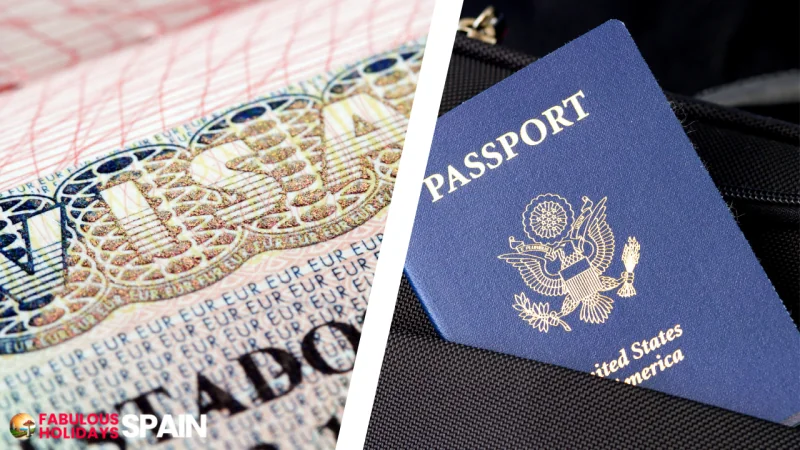
To travel from the United States to Spain, you will need to meet the following requirements:
- Visa Requirements: U.S. citizens are not required to apply for a visa to travel to Spain for tourism or business purposes for stays of up to 90 days. However, you must have a valid passport that is valid for at least three months beyond your intended date of departure from Spain. Your passport must also have been issued within the last 10 years.
- Documentation: In addition to your passport, you may be asked to present the following documentation when entering Spain:
- E-Visa Waiver Program (ESTA): If you are travelling to Spain from the United States, you will need to obtain an ESTA (Electronic System for Travel Authorization) before you travel. The ESTA is a pre-authorization for travel to the Schengen visa-free territories, including Spain. You can apply for an ESTA online for a fee of $21.
- Proof of Accommodation: You may be asked to show proof of accommodation, such as a hotel booking confirmation or a rental agreement.
- Proof of Financial Means: You should be able to demonstrate that you have sufficient funds to support yourself during your stay in Spain. This could include bank statements, credit card statements, or travel insurance documents.
- E-Visa Waiver Program (ESTA): If you are travelling to Spain from the United States, you will need to obtain an ESTA (Electronic System for Travel Authorization) before you travel. The ESTA is a pre-authorization for travel to the Schengen visa-free territories, including Spain. You can apply for an ESTA online for a fee of $21.
- COVID-19 Measures: Starting February 2023, access points to Spain do not enforce any sanitary requirements for COVID-19. For updated information, please consult the Health Ministry’s webpage.
Please check the latest travel advice from the Spanish government for the most up-to-date information on COVID-19 measures.
Official websites for further reading and updated information:
- U.S. Department of State: Spain: https://es.usembassy.gov/
What is Required to Travel from Germany to Spain?
As of December 30, 2023, the following travel requirements apply for travel from Germany to Spain:
Visa requirements:
German nationals do not require a visa to enter Spain for up to 90 days within 180 days. This applies to all German nationals, including those who hold German passports with the phrase “European Union” stamped on them.
Documentation:
To travel to Spain from Germany, you will need to present the following documentation:
- A valid passport: Your passport must be valid for at least three months beyond your intended date of departure from Spain. It must also have been issued within the last ten years.
- Proof of accommodation: You may be asked to show proof of accommodation, such as a hotel booking confirmation or a rental agreement. This is not strictly required, but it is recommended to have it in case you are asked.
- Proof of financial means: You should be able to demonstrate that you have sufficient funds to support yourself during your stay in Spain. This could include bank statements, credit card statements, or travel insurance documents.
- COVID-19 Measures: Starting February 2023, access points to Spain do not enforce any sanitary requirements for COVID-19. For updated information, please consult the Health Ministry’s webpage.
What is Required to travel from France to Spain?
As of December 30, 2023, the following travel requirements apply for travel from France to Spain:
Visa requirements:
French citizens do not require a visa to enter Spain for up to 90 days within 180 days. This applies to all French nationals, including those who hold French passports with the phrase “European Union” stamped on them.
Documentation:
To travel to Spain from France, you will need to present the following documentation:
- A valid passport: Your passport must be valid for at least three months beyond your intended date of departure from Spain. It must also have been issued within the last ten years.
- Proof of accommodation: You may be asked to show proof of accommodation, such as a hotel booking confirmation or a rental agreement. This is not strictly required, but it is recommended to have it in case you are asked.
- Proof of financial means: You should be able to demonstrate that you have sufficient funds to support yourself during your stay in Spain. This could include bank statements, credit card statements, or travel insurance documents.
- COVID-19 Measures: Starting February 2023, access points to Spain do not enforce any sanitary requirements for COVID-19. For updated information, please consult the Health Ministry’s webpage.
Tips for first-time visitors to Spain
Spain is a beautiful and diverse country with a rich history, culture, and cuisine. It’s a great destination for first-time visitors who want to experience something new and exciting. Here are some tips for planning your trip to Spain:
1. Decide where to go: Spain is a large country with many different regions to explore. Some of the most popular tourist destinations include Madrid, Barcelona, Seville, Granada, and Valencia. Each city has its unique charm and attractions.
2. Book your flights and accommodation in advance: Especially during peak season, it’s important to book your flights and accommodation in advance to avoid disappointment. You can find a wide range of accommodation options to suit all budgets, from luxurious hotels to budget-friendly hostels.
3. Learn a few basic Spanish phrases: Even if you don’t speak Spanish fluently, learning a few basic phrases can go a long way in making your trip more enjoyable. Spanish people are generally very friendly and welcoming, and they appreciate the effort made by tourists to learn their language.
4. Try siesta: The siesta is a traditional Spanish custom of taking a break in the afternoon, usually between 2 pm and 5 pm. Many businesses and shops will close during this time, so it’s a good idea to plan your day accordingly.
5. Eat tapas: Tapas are small plates of food that are typically shared. They’re a great way to sample a variety of Spanish flavours and to experience the lively Spanish tapas culture.
6. Try sangria: Sangria is a traditional Spanish drink made with red wine, fruit juice, and brandy. It’s a refreshing and delicious way to cool off on a hot Spanish day.
7. Visit the Alhambra: The Alhambra is a UNESCO World Heritage site and one of the most popular tourist attractions in Spain. It’s a Moorish palace complex located in Granada that’s known for its stunning architecture and gardens.
8. Go flamenco dancing: Flamenco is a traditional Spanish dance that’s characterized by its passionate and energetic movements. There are many flamenco shows to choose from in Spain, so you’re sure to find one that’s perfect for you.
9. Take a day trip to the beach: Spain has a long coastline with many beautiful beaches. If you’re looking for a relaxing break from sightseeing, take a day trip to the beach and enjoy the sun, sand, and sea.
10. Savor the Spanish food: Spanish cuisine is world-renowned for its delicious flavours and fresh ingredients. Be sure to try some of the local specialities, such as paella, jamón ibérico, and tapas.
Here are some additional tips that may be helpful for first-time visitors to Spain:
- Bring comfortable shoes: You’ll be doing a lot of walking, so comfortable shoes are essential.
- Pack for all types of weather: Spain has a Mediterranean climate, but there can be a lot of variation in temperature, depending on the region and the time of year. Be prepared for warm weather, but also pack layers for cooler evenings.
- Don’t be afraid to haggle: Haggling is a common practice in Spain, especially in markets and shops. Don’t be afraid to offer a lower price than the asking price, and you may be surprised at how much you can save.
- Be patient: Spaniards are known for their laid-back attitude. Don’t expect everything to be done as quickly as you might be used to in your home country.
- Relax and enjoy yourself: Spain is a beautiful and welcoming country with a lot to offer visitors. Relax, have fun, and soak up the Spanish lifestyle.
What to expect when visiting Spain for the first time
Visiting Spain for the first time can be an incredibly enriching and unforgettable experience. This fascinating country offers a wealth of historical, cultural, and natural wonders that are sure to captivate even the most discerning traveller. Here’s a glimpse into what you can expect when you visit Spain:
Diverse landscapes and stunning scenery: Spain’s diverse landscapes range from snow-capped mountains and lush forests to sun-kissed beaches and arid deserts. Explore the majestic Pyrenees mountains, the rolling hills of Andalusia, the rugged coastline of the Costa Brava, and the otherworldly landscapes of the Sahara-like Bardenas Reales Natural Park.
The rich history and captivating heritage: Spain’s rich history is evident in its stunning architecture, from the ancient Roman ruins of Tarragona to the medieval castles of Toledo and the Moorish masterpieces of the Alhambra in Granada. Delve into the fascinating history of the Reconquista, the Spanish Inquisition, and the artistic and literary movements that have shaped the country’s cultural identity.
Authentic culture and vibrant traditions: Immerse yourself in the vibrant Spanish culture, characterized by lively festivals, passionate flamenco dancing, and delectable tapas culture. Witness the colourful Semana Santa processions, experience the fiery energy of flamenco performances, and savour the flavours of traditional Spanish cuisine, from paella to churros con chocolate.
Warm and welcoming people: Spanish people are renowned for their warm hospitality and friendly demeanour. Embrace the concept of “la hora del vermut” (aperitivo hour) and engage in conversations with locals over a glass of vermouth or sangria. Enjoy the lively atmosphere of tapas bars, where you can sample local delicacies and mingle with the locals.
Celebrate life and embrace the art of relaxation: Spain’s motto, “viva la vida” (long live life), reflects the country’s laid-back and jovial attitude. Embrace the siesta tradition, taking a break from the midday heat to relax and recharge. Indulge in the culinary delights of Spain and savour the flavours of tapas, paella, and regional specialities.
Explore ancient traditions and modern marvels: Combine the charm of ancient traditions with modern advancements. Visit the fascinating Picasso Museum in Barcelona, marvel at the futuristic architecture of Santiago Calatrava’s buildings, and experience the thrill of watching a bullfight in a traditional arena.
Important Things to Know Before Traveling to Spain
Planning a trip to Spain can be an exciting adventure, but it’s crucial to gather essential knowledge to ensure a smooth and enjoyable experience. Here’s a comprehensive guide to the important things to know before travelling to Spain:
Visa Requirements:
- Most nationalities, including European Union ones, do not require a visa for short-term stays in Spain.
- However, checking the latest visa regulations for your specific nationality is advisable before travelling.
- Visitors from non-EU countries may require a visa, and it’s recommended that you apply well in advance of your trip.
Arrival and Departure:
- Spain’s primary international airports are Madrid-Barajas Adolfo Suárez Airport (MAD) and Barcelona-El Prat Airport (BCN).
- Several other airports serve major cities, including Seville, Malaga, and Valencia.
- Public transportation, such as taxis, buses, and the metro, is readily available for convenient travel within and between cities.
Currency and Cash:
- The official currency of Spain is the Euro (€).
- It’s recommended to exchange currency or withdraw cash from ATMs upon arrival at Spanish airports or major cities.
- Credit cards are widely accepted in tourist areas, but carrying some cash is always advisable, especially for smaller establishments.
Language and Communication:
- Spanish is the official language of Spain.
- English is generally spoken in tourist areas and major cities, but learning basic Spanish phrases can enhance your experience.
- Apps like Google Translate can be helpful for communication and translation.
Transportation and Mobility:
- Spain has an extensive network of buses, trains, and high-speed trains (AVE) that connect major cities and towns.
- Renfe is the national railway company offering affordable and efficient rail travel throughout Spain.
- Public transportation within cities is generally affordable and efficient, with metro, bus, and taxi options.
Accommodation:
- Spain offers many accommodations, from luxurious hotels and charming bed and breakfasts to budget-friendly hostels and apartments.
- Consider your budget, desired location, and amenities when selecting accommodation.
- Book accommodations in advance, especially during peak seasons.
Local Customs and Etiquette:
- Spaniards are generally warm and welcoming and appreciate a friendly attitude and basic Spanish language skills.
- Appreciate the siesta tradition, taking a break from the midday heat for a rest and a leisurely meal.
- Follow the unspoken rules of queuing (waiting in line) and respect local customs and traditions.
Cultural Considerations:
- Spain is a predominantly Catholic country, so respect religious customs and traditions.
- Dress modestly, especially when visiting religious sites or cultural institutions.
- Avoid loud behaviour and excessive public displays of affection.
Dining and Cuisine:
- Tapas are small plates of food, typically shared, offering a great way to sample Spanish cuisine.
- Paella, a rice dish with seafood or meat, is a national and must-try dish.
- Sample the flavours of regional specialities, such as jamón ibérico (cured ham), churros con chocolate (fried dough with chocolate sauce), and gazpacho (cold tomato soup).
Safety and Security:
- Spain is generally a safe country for tourists, with low crime rates.
- Use common sense precautions, such as avoiding carrying excessive cash or valuables, and be alert to your surroundings.
- Always keep your passport, valuables, and travel documents secure.
Packing Essentials:
- Pack comfortable shoes for extensive walking and exploring.
- Pack for varying weather conditions, especially during different seasons.
- Adapt your packing to your activities and desired clothing style.
- Consider packing a reusable water bottle and a small towel for public restrooms.
Additional Tips:
- Download offline maps and translation apps for convenient navigation and communication.
- Purchase a travel adapter to ensure compatibility with Spanish electrical outlets.
- Familiarize yourself with the local Spain emergency numbers and procedures.
- Be prepared for possible disruptions during public holidays and festivals.
- Buy eSIM (read Airalo review here) instead of using your normal phone provider’s roaming tariff
- Get ready to see cockroaches in Spain (blame global warming!)
This concludes the guide to what you should know before travelling to Spain. Now you know more than 99% of the tourists you will meet in Spain.
Some say planning is half of the job done. For travel, it is true!
We invite you to read more of our guides and recommendations before travelling to Spain.
